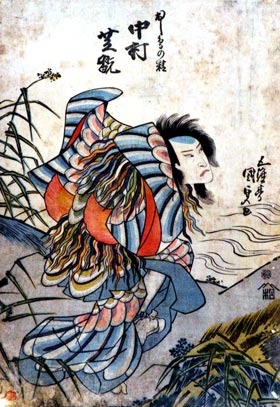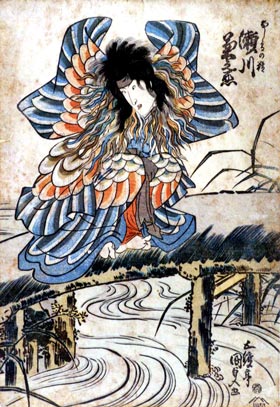| OSHIDORI |
| Dance title | Oshi no Fusuma Koi no Mutsugoto 1828 Shijűhatte Koi no Showake Imosedori Sugata no Masayume 1775 Shijűhatte Koi no Showake |
| Authors | Kanai Sansh˘ (lyrics), Namisaki Tokuji I (music) for 1775 "Shijűhatte Koi no Showake" Segawa Jok˘ II (lyrics), Kishizawa Shikisa V (music) for 1828 "Imosedori Sugata no Masayume" |
| History |
The first part of the dance "Oshidori" was premiered in the 11th lunar month of 1775 at the Nakamuraza, as part of the kaomise drama "Hana Zum˘ Genji Biiki". The relevant section of this was a Tomimoto-based dance-drama entitled "Shijűhatte Koi no Showake" [more details]. "Shijűhatte Koi no Showake" was revived by Segawa Jok˘ II in the 1st lunar month of 1828 at the Nakamuraza, as the first part of a two-part dance-drama. It was still Tomimoto-based, and formed the "Sum˘" part of the story. The second part of the drama was called "Imosedori Sugata no Masayume" [more details]. This was Tokiwazu-based, and was the "Oshidori", or Mandarin ducks, part of the play. Later, the Tomimoto music was replaced by Kiyomoto music. "Oshidori" then went into oblivion until it was revived by Nakamura Utaemon VI, who worked with Nagauta and Tokiwazu musicians to create new music for the piece. The "Sum˘" part was created by the Nagauta musicians Kineya Eiji, Yoshimura Gor˘ji II and Tanaka Denzaemon XI; the "Oshidori" part was created by the Tokiwazu musicians Tokiwazu Chitosedayű and Tokiwazu Kikusabur˘; the choreography was supervised by Fujima Kanjűr˘ VI. It was first staged at the Kabukiza in March 1954, as part of the first edition of the Tsubomikai, a study group led by Nakamura Utaemon VI [more details]. It had only two performances, on the 27th and 28th, but was so successful that it was staged again a few months later as part of the regular July Kabuki programme at the Kabukiza, with different casting for the male roles [more details]. This history was written by Sh˘riya Aragor˘ and corrected by Marion Hudson (April 2011). |
| Structure |
This dance-drama is in two sections, "Sum˘" (in Nagauta or Kiyomoto) and "Oshidori" (in Tokiwazu). |
| Key words |
Matano Kagehisa Nagauta Oshidori Shosagoto Sum˘ Tokiwazu Tomimoto Tsubomikai |
| Summary |
The dance is in two sections, Sum˘ and Oshidori. The first section, after a prelude relating the history of Sum˘ wrestling, depicts, in dance form, a bout between Matano Gor˘ Kagehisa, a previously unbeaten wrestler, and the handsome Kawazu Sabur˘ Sukeyasu Sukeyasu, with whom the courtesan Kisegawa is in love. Kisegawa acts as umpire, and, after a very close-run contest, Sukeyasu wins both the match and her hand. Although the defeated Kagehisa has appeared to be a generous loser, he is, in fact, now full of envy and malice towards Sukeyasu, whom he now wishes to destroy. He sees a pair of mandarin ducks swimming on the lake, and kills the male bird with a throw of his dagger. Mandarin ducks are a symbol of marital fidelity in the East, and as a result of his action the female will, according to folklore, pine away and die. Kagehisa also knows that if he can deceive Sukeyasu into drinking the blood of the male bird (which he intends to mix with his sake), then Sukeyasu will run mad. The second section of the dance takes place later that night. The spirit of the female mandarin duck (played by the same actor as Kisegawa) rises on the hanamichi in the form of a young maiden, and laments the loss of her mate. Sukeyasu, as she knows, has now drunk the male bird's blood, and as a result is possessed by his spirit. He enters, and the two express their undying love for each other, and their hatred of Kagehisa who has separated them. Kagehisa is secretly watching, and defies them. The pair do battle with him, revealing their true nature as birds in a bukkaeri costume change. It is conventionally assumed that good will defeat evil, and the piece ends with a spectacular mie. Summary written by Marion Hudson (March 2011). |
 |
 |
|
The actors Nakamura Shikan II and Segawa Kikunoj˘ V playing the roles of the spirits of the male and female mandarin ducks in the dance-drama "Imosedori Sugata no Masayume", which was staged in the 1st lunar month of 1828 at the Nakamuraza (print made by Utagawa Kunisada I) |
|
|
|
| Contact | Main | Top | Updates | Actors | Plays | Playwrights | Programs | Links | FAQ | Glossary | Chronology | Illustrations | Prints | Characters | Derivatives | Theaters | Coming soon | News |